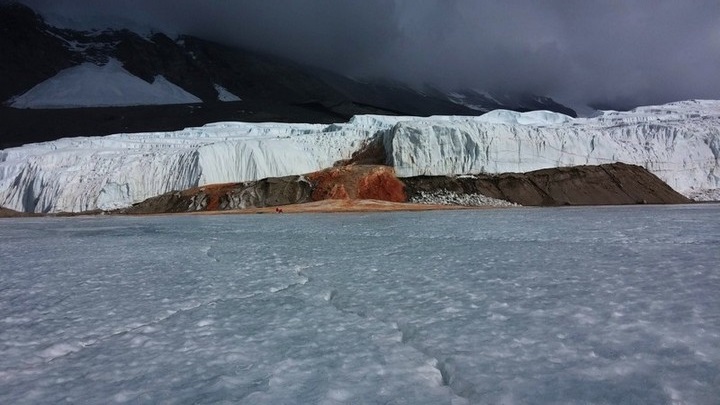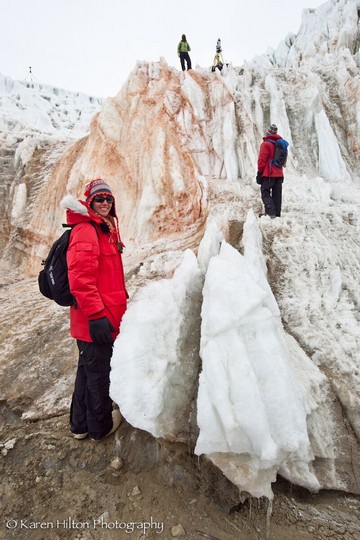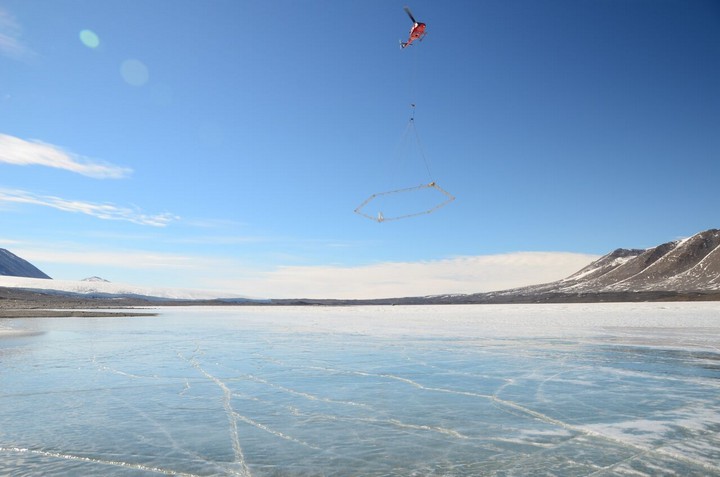By Sara ElShafie
When Australian geologist Griffith Taylor explored Antarctica in 1911, he came across a glacier with a feature resembling a bleeding wound in the ice. The oddity came to be known as “Blood Falls.”
Almost a century later, the mysteries of Blood Falls are coming to light. Dr. Jill Mikucki, a microbial ecologist at Middlebury College in Vermont, has spent almost three collective years on the frozen continent investigating the Blood Falls site at Taylor Glacier. Mikucki discovered that the liquid oozing from the crevasse at Blood Falls is actually clear. The blood red color comes from iron in the liquid that oxidizes at the surface. The iron could be evidence of an unusual microbial ecosystem hidden beneath the glacier.
Mikucki wants to know how microbial communities can survive in frigid environments with no sunlight and no oxygen. Her interest grew from a lifelong fascination with snow, science fiction, and life on other planets. “It came together for me when I started to learn about the diversity of extremophiles [organisms that live in extreme environments], and that microbes can live in subzero temperatures.”

Subglacial environments may represent the best analogous system to a possible microbial community elsewhere in our solar system. “When you think about the ecological niche of a possible microbe living on Mars or Europa [a moon of Jupiter]: it’s going to be cold; in some cases probably really salty; it might be below a thick ice cap,” Mikucki says.
Blood Falls is one of the few places on Earth where Mikucki can directly sample a subglacial environment. The samples of brine (salt water) from Blood Falls contain a diverse community of microbes with evidence of an unusual survival mechanism. There are high amounts of dissolved inorganic carbon in the brine, as well as sulfur and other elements, which likely dissolved from the bedrock. Mikucki thinks that the microbes living on the subglacial bedrock use a chemical cycle called chemolithoautotrophy (food production from rock-derived chemicals) to obtain energy and raw materials for growth. Iron may be one of the waste products of this lifestyle, just as CO2 is a waste product of respiration in humans. The ability to synthesize food in the absence of sunlight and oxygen may be what allowed these microbes to thrive for at least 1.5 million years since Taylor Glacier last advanced.
Analyses of samples recovered at Blood Falls revealed that the microbes beneath Taylor Glacier are most genetically similar to microbes from cold marine environments. Both are adapted to survive in frigid, salty, anoxic conditions. “This reflects a marine history for this glacial feature that is now thirty miles inland,” Mikucki says.
In order to understand the origins of these strange microbes, Mikucki needs to obtain evidence from the brine before it reaches the surface. That means sampling the brine from within Taylor Glacier. Mikucki recently collaborated with a team of German engineers that developed a specialized drill called the “IceMole.” A prototype for future drilling projects on the moons of Jupiter, the IceMole can probe through the ice in any direction to a depth of 50 meters. It can also collect samples. After a successful test run with the IceMole, Mikucki is currently studying the first brine samples collected from within Taylor Glacier.

Mikucki and colleagues think that Antarctic subglacial ecosystems may be a source of essential nutrients for the Southern Ocean surrounding the continent. Taylor Glacier itself is isolated from the coast, but other glaciers nearby empty directly into the ocean. If any glaciers on the coastal margin also harbor iron-producing microbial communities, then subglacial groundwater seepage may be a crucial source of iron for the ocean. Iron is a potentially limiting essential nutrient for photosynthetic organisms in the Southern Ocean. An influx of iron from subglacial runoff could increase marine photosynthesis in that region.
“We haven’t really thought about Antarctic groundwater before,” explains Mikucki. Iron deposition in ocean surface waters is generally presumed to come from water melting from the glacier itself, or even from dust blown in from distant sand dunes. Mikucki and her colleagues propose that iron reaching the Southern Ocean could be the waste product of microorganisms living beneath glaciers.
In order to understand the potential magnitude of this ecosystem’s contribution, Mikucki needed to know the extent of the brine-saturated permafrost beneath Taylor Glacier. “I can’t actually look at the environment that my microbes are living in because it’s covered with ice,” Mikucki says.
Mikucki enlisted the help of a team of hydrogeophysicists from Denmark. The team had developed an advanced sensor called “SkyTem” that measures resistivity in the ground. It was designed to look for minerals and aquifers, but also functioned well to map the extent of the brine system under the glacier. The sensor, a giant wooden polygon suspended from a helicopter, transmits an electromagnetic wave into the ground and measures the rate of the wave’s diffusion beneath the surface. Because solids (like ice or permafrost) have a much higher resistivity than liquids (like water or brine), the sensor was able to create a clear contrast between the brine in the permafrost and the ice above it.
The team discovered that the brines actually extend for hundreds of meters underground. Mikucki suggests that these brines may be the remnants of an ancient lake system that was periodically flooded by marine waters. Freezing and concentrating the water may have reduced the lake level, concentrating the salt, and eventually leaving the ground saturated with brine before it too was covered with ice.
There is still much to understand about Blood Falls and the subglacial world it exposes. “I never completely figure out what’s going on with this feature,” Mikucki says. “Every year I go back, I get data, I write a paper, I go back again and I’m like ‘Gah!’ It always wins. It keeps you guessing.”
Jill Mikucki presented the results of this research at the 2016 annual meeting of the Society for Integrative and Comparative Biology in Portland, OR.


